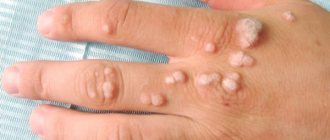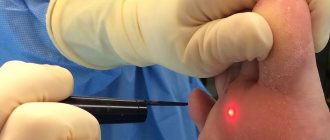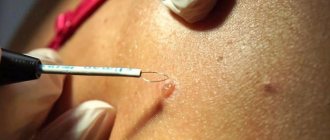Doctors Cost
Price list Doctors clinic
A plantar wart is a nodule or plaque with an uneven surface located in the place where the foot takes the greatest load. Most often, a wart forms on the heel or at the base of the big toe. Treatment of a plantar wart in a child involves removing the altered cells using one method or another.
The causes of a benign formation are usually infection with the papilloma virus. The issue of intervention is decided in each case individually.
Indications for removal
In the absence of complaints and the risk of complications in a young child, a wart can be observed. At the age of 4 years, formations are rarely removed. There are several medical and other indications for the removal of plantar warts in children:
- Discomfort and complaints of the child. Formations on the sole are accompanied by discomfort when walking, pain, and the inability to perform the usual amount of physical exercise. Also, a wart can become a problem when choosing suitable shoes.
- Rapid spread. In some cases, plantar warts spread, merge into a single formation, and increase in size.
- Danger of infection. The wart tissue retains papilloma viruses, which can be transmitted to other family members. Viral particles in the thickness of the formation can pose a danger to the child himself; there are cases of self-infection with the appearance of warts on the other foot and parts of the body.
- Weakening of immune forces. A wart is a source of infection and can affect immune function and weaken defenses, which is especially dangerous for children with chronic somatic and endocrine diseases.
- Immunodeficiency. Children with immunodeficiency of various origins are advised to remove viral formations as quickly as possible, this will help prevent the spread of infection.
When visiting a doctor, it is important to talk about the child’s health in general: chronic diseases, medications taken on an ongoing basis. This will help make a decision about the advisability of immediate removal of the formation.
How does HPV infection occur and warts appear?
If the infection did not occur in utero or during childbirth, HPV infection can occur through bodily contact with a carrier. Very often this happens in children's groups in kindergarten or elementary school. From 3 months to 10–11 years, asymptomatic carriage occurs, this applies to most cases. The first manifestations are at an older age, before puberty or immediately at its beginning.
Today there are 16 well-studied types of HPV and more than 100 unstudied ones. Carriage does not necessarily mean the manifestation of the disease on the skin: the formation of a wart involves preliminary microtrauma of the skin, a temporary local or general decrease in protective forces. In this case, the virus penetrates the epidermal cells and begins to multiply. The period from infection to the appearance of a wart can take a long time, up to several years. It is believed that the hair follicle is a kind of reservoir for the virus.
Who is contraindicated for
It is possible to remove a plantar wart from a child in almost every case; the procedure has almost no strict contraindications. However, it is important to accept some limitations. Thus, in children under 4 years of age, in the absence of high risks of complications and severe discomfort, surgery may be postponed.
If you have recently undergone routine vaccination or suffered from an acute respiratory viral infection, your doctor will recommend waiting 10 to 14 days to avoid complications.
General contraindications for all intervention methods include the following:
- purulent diseases of the skin, subcutaneous tissue;
- bleeding disorders;
- taking anticoagulants, antiplatelet agents (temporary contraindication);
- high risks of keloid scar formation;
- exacerbation of chronic diseases;
- decompensated diabetes mellitus.
If the patient has time restrictions, the doctor will tell you when the surgery can be scheduled.
Wart
Warts are a dermatological disease characterized by the appearance of small lumps on a child’s skin that can protrude above its surface or grow inward.
The cause of the appearance of such formations is various strains of the human papillomavirus (HPV). Frequent trauma, increased sweating, and possible contact with infected people are additional factors that increase the risk of pathology. The virus is transmitted to a child from another person through direct contact or through personal hygiene and household items. Warts do not belong to the group of dangerous diseases, but may be accompanied by the following symptoms:
- change in skin color at the site of tumor growth;
- pain, which is especially pronounced when warts grow on the soles of the feet;
- cosmetic defect.
The severity of symptoms depends on the number and location of tumors.
Diagnostics
Warts are a diagnosis that can be easily established by qualified specialists. Accurate diagnosis is carried out during the initial examination. The doctor examines the lumps on the skin and studies the patient’s complaints. To clarify the information received, we also use PCR diagnostics to identify the genetic material of HPV, and histological examination (after removal of the wart).
Preparing for surgery
Before wart removal, standard preoperative preparation is carried out, which is aimed at:
- assessment of general health;
- identification of possible contraindications;
- prevention of intra- and postoperative complications.
The little patient is examined by an anesthesiologist to choose the optimal method of pain relief. Wart removal for children is carried out using local anesthetics, under general anesthesia using hardware-mask anesthesia. In each individual case, the dose of anesthetic is calculated depending on the age and body weight of the child.
Preoperative preparation includes: Plan for examining the child before minor surgery (nevus, granuloma, etc.).
Operation
The specialists of our center understand that any operation, even the most minor one, is stressful for the child. To reduce discomfort during the recovery period, our surgeons prefer minimally invasive interventions. This allows you to reduce the risk of damage to nerve endings, blood vessels and other structures during manipulation, allowing you to significantly reduce pain for the child.
Removal of the formation is carried out within healthy tissues. It is possible to use an electric knife. After treating the surgical field with an antiseptic and anesthesia, the doctor makes an incision along the length of the formation and removes the wart. The wound is sutured using low-traumatic needles with cosmetic sutures. This prevents the formation of scars, which guarantees a good cosmetic effect.
Rehabilitation period
“Same Day Surgery” allows the patient to leave the clinic within a few hours after the operation. During this time, parents and their child stay in a comfortable room designed for proper rest. Every other day, children visit the manipulation room to change the bandages. Surgeons evaluate the quality of wound healing and, if necessary, make corrections in the postoperative period. After surgery, you should refrain from intense physical activity for a week. Once the wound has healed, the cosmetic suture is removed. A follow-up inspection is carried out after 30 days (approximate time frame). Full recovery may take up to 1-2 months.
Forecast
Removing a wart is a radical treatment. The tumor is eliminated completely, but the risk of relapse is possible.
Cost of wart excision surgery
from 1500 rub. up to 5000 rub. depending on the type of anesthesia.
Moles
Nevi, or so-called moles, are the largest group of skin tumors, the appearance of which can begin in early childhood and continue throughout almost the entire life. There are many different types of moles in children: from light brown to almost black in color, ranging in size from 0.5 to 3 or more centimeters and different in shape - from smooth and round to star-shaped and from small spots to large nodules. Localization of moles is possible on any area of human skin. Some of them are completely harmless, but some can be dangerous. Therefore, it is very important to periodically consult a dermatologist, who will be able to make the correct diagnosis based on examination using a dermatoscope and, in accordance with the diagnosis, prescribe the necessary therapy.
Orlov Alexey Vladislavovich, dermatologist, CMN
Pediatric dermatology services also include laser removal of papillomas.
Why do you need to remove warts?
First of all, papilloma is a virus, but for people it has become an aesthetic problem. Many suffer, feel embarrassed, and feel insecure because of these small defects.
But the main thing you need to remember is that a person with such a benign formation is a direct carrier of the virus, he can infect others. If you accidentally touch it, there is a danger of tearing off the growth, causing severe bleeding. In no case should we forget that with constant injury and exposure to sunlight on the affected area of the skin, it can become malignant.
Therefore, it is very important to eliminate such neoplasms in a timely and correct manner. Under no circumstances should you self-medicate: tie a thread to the base and wait until it falls off.
As soon as you notice that something is wrong with your skin, immediately contact professionals who will quickly and efficiently remove the wart with a laser.
Laser wart removal results
Our specialists are professionals in their field, they always strive for results. Therefore, you can be confident in the quality of the work performed. This procedure is the most effective. The growth is removed from the roots, and there is no risk of relapse.
After healing, only a small postoperative scar remains at the site of the operation, which is very difficult to notice, and over time it almost disappears altogether.
The effect after surgery is visible to the naked eye, which the client can verify immediately, without leaving the specialist’s office; the wart completely disappears after laser removal. The difference before and after is obvious, and you will be more than pleased that you contacted our clinic for help.
Types of warts
There are such types of warts as ordinary, flat, and so-called genital warts. Let's take a closer look at them.
Common wart formations. These are keratinized elevations of a very dense nature, with an uneven, sometimes covered with hairs, surface. The size varies, from the head of a pin to a fairly large pea. Such formations can merge together and form large plaques.
Plantar warts - appear in places where shoes pressure, especially in people who sweat a lot. Very dense, keratinized, gray-dirty plantar formations, which are characterized by severe pain that prevents walking; sometimes even cause temporary disability.
Flat, or youthful formations. Their appearance is provoked by skin irritation, and they can also appear at the site of scratches and cuts. Mainly found in children and adolescents.
Genital warts. Small pink nodules that most often appear in the genital area, or in the inguinal or intergluteal folds. This occurs when hygiene procedures are ignored or due to sexual transmission.
Self-removal of warts is strictly contraindicated. The main reason is that they can become injured or turn into malignant tumors and cause cancer.
To diagnose the disease, wart tissue cells are often examined. This process is called histological examination. For example, condylomas lata have a similar structure to some manifestations of sexually transmitted diseases, in particular syphilis, so when they are detected, a blood test is performed to detect syphilis.
Diagnosis of plantar warts
Plantar warts are usually not difficult to identify. But with an atypical external picture, a differential diagnosis is made between hyperkeratosis and plantar calluses using dermatoscopy - examination of the suspicious area under magnification. In some cases, it may be necessary to remove the top layer of keratinized growth. The absence of a skin pattern and the presence of dark spots from thrombosed capillaries speak in favor of warts. In doubtful cases, a PCR test for HPV is performed.
In addition, plantar warts should be distinguished from palmoplantar syphiloids. The latter is supported by their multiplicity and arrangement in the form of arcs or rings. The final diagnosis is made after specific tests for syphilis, for example RPR - anticardiolipin test.
Reasons for appearance
HPV is the main cause of warty growths.
No one is immune from the virus entering the body. Children and older people are more susceptible to infection than others, but they also occur quite often in adults.
The virus is present on household items (towels, combs), in transport, and on the street. It can enter the body when a person’s immune system is weakened, through scratches and cracks in the skin, and can even be damaged through sexual contact.
The main reason has always been and remains - non-compliance with personal hygiene rules. If you do not wash your hands, do not treat wounds, or use other people’s personal care products, then this is a direct path to HPV entering the body, and then the appearance of benign papillomas on the body.










